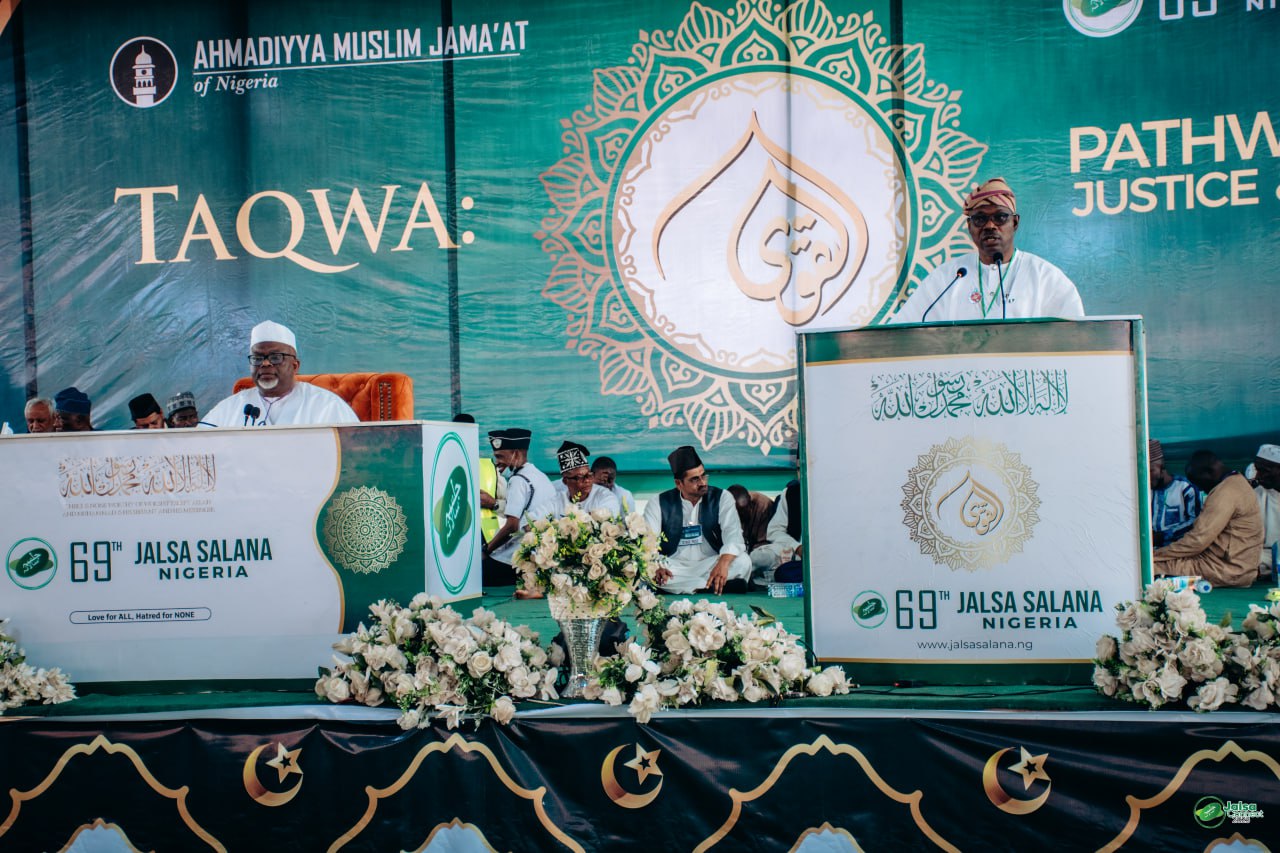By Abdulmusowir Akorede Taiwo
Introduction
There are various gatherings for conventions across the world, Which may Include musical concerts, political gatherings or religious events.
In Which people may benefit from them in various manners.
However, conventions are not solely limited to worldly benefit. The Hajj is an example of this. The spiritual rewards and benefits one can gain from this pilgrimage may even be beyond human comprehension. Another such popular convention is that of the Ahmadiyya Muslim community known as Jalsa Salana which began in 1891 in a village known as Qadian, which was attended by 75 members of the community in its Inception but has now expanded substantially. These conventions are now held in several countries on an international scale, sometimes with over 38,000 attendees from hundreds of countries. The convention is more than just a meeting of people from various places around the world. The convention (Jalsa Salana) was established by the Promised Messiah and Imam Mahdi, Hazrat Mirza Ghulam Ahmad(as). He (peace be upon him) presented the main purposes of this convention which include :
- To increase one’s communion with Allah the Almighty
- To pray for those brothers who have passed away
- Meeting new members and increase in Brotherhood
- To gain and increase in knowledge
These four principal purposes presented by the Promised Messiah (as) are being fulfilled in every aspect of the Annual Convention [Jalsa Salana]. The most obvious being the purpose of increasing one’s communion with Allah the Almighty. With the entire schedule revolving around the five daily prayers, a person inevitably finds himself in a spiritually uplifting atmosphere.
Having explained briefly the historical background and purpose of Jalsa Salana, we will now delve into some facts about Jalsa Salana which will be listed and explained below.
- THE BIG JALSA: During the first Jalsa Salana in 1891, the promised Messiah announced that the convention would continue every year on the 27th of December, Accordingly in 1892 which is known as THE BIG JALSA among those that attended because of how this Jalsa was held next to the pond in Qadian, the stage was built from the mud collected from in and around the pond. The Promised Messiah(as) was sat upon the raised platform on which carpet had been laid, jamaat members were seated around him on the floor.
- The Humble Beginnings and Global Growth of Jalsa Salana:
The first Jalsa Salana was held in the remote village of Qadian, India, in 1891. Initiated by Hazrat Mirza Ghulam Ahmad, the Promised Messiah and founder of the Ahmadiyya Muslim Community, this gathering brought together only 75 members. Despite the modest attendance, it laid the foundation for a unique spiritual tradition that has since blossomed into a global phenomenon.
The purpose of this initial gathering was not merely to convene but to instil moral and spiritual upliftment among the attendees and to promote unity and brotherhood within the burgeoning community. Hazrat Mirza Ghulam Ahmad emphasized that the Jalsa was not intended to be a worldly affair but a sacred assembly aimed at strengthening one’s faith and fostering a connection with Allah.
From these humble beginnings, the Jalsa Salana has grown to become an international event held in dozens of countries. Today, these conventions attract tens of thousands of attendees, sometimes exceeding 38,000 participants from hundreds of nations. The event serves as a microcosm of the unity and diversity of the global Ahmadiyya Muslim Community.
- Migration of Jalsa Salana to Rabwah (1947): After the partition of India in 1947, the Ahmadiyya Muslim Community relocated its headquarters to Rabwah, Pakistan and the Jalsa Salana also shifted to this new base. Despite challenges like displacement and limited resources, the community continued to organize the event with great devotion. So The migration of Jalsa Salana to Rabwah demonstrated the resilience and determination of the community. It served as a unifying event for Ahmadi members during a turbulent period, reinforcing their faith and collective identity.
- A LEGACY OF SACRIFICE AND TRUST IN GOD:
The history of Jalsa Salana is adorned with profound lessons of sacrifice, selflessness, and unwavering trust in Allah. One notable incident, as narrated by Hazrat Munshi Zafar sahib(ra) highlights the extraordinary commitment of Hazrat Mirza Ghulam Ahmad (as), the Promised Messiah.
During an early Jalsa, financial resources dwindled to the point where there was no food left to serve the guests. At that time, there was no formal Chanda (donation system) for the event’s expenses, and the Promised Messiah bore the financial burden personally. When informed of the crisis, the Promised Messiah instructed Mir Sahib to sell jewellery belonging to his wife to purchase food for the guests.
This act of sacrifice not only addressed the immediate need but also illustrated the Promised Messiah’s emphasis on hospitality as a sacred duty. Two days later, when funds again ran out, the Promised Messiah displayed unshakable faith, remarking:
“In obedience [to God] we have exhausted all possible worldly means, now we need not to worry; the One whose guests these are will Himself take care of them.”
This profound trust in Allah encapsulates the spiritual ethos of Jalsa Salana, where reliance on divine providence and the spirit of self-sacrifice has always been central.
This story serves as a timeless reminder of the principles of sacrifice, hospitality, and faith that continue to define Jalsa Salana. It is a testament to how the Promised Messiah’s actions and teachings laid the foundation for the spiritual and logistical success of these gatherings across generations.
- The inception and International Significance of Jalsa Salana UK :
The Jalsa Salana UK holds a unique place in the history of the Ahmadiyya Muslim Community. It was first held in 1964, marking the beginning of a tradition that would grow into a major international event. The UK Jalsa has evolved into an international convention, largely because the Khalifa now resides in the UK following the migration from Pakistan.
This migration was necessitated by the persecution faced by the Ahmadiyya community in Pakistan, particularly after the promulgation of laws that restricted Ahmadi members religious freedom. The presence of the Khalifa in the UK has made the Jalsa Salana UK a focal point for Ahmadis worldwide, offering a rare opportunity to gather in the physical presence of their spiritual leader.
Between 1985 and 2004, the Jalsa Salana UK was held at a site near Tilford, officially known as Islamabad. This location became synonymous with the growth of the Jalsa in the West. However, as attendance numbers continued to rise, averaging 30,000 participants annually from over 100 countries, The need for a larger venue became apparent.
With this, the Ahmadiyya Jama’at UK acquired a 208-acre site near Alton, named Hadiqatul-Mahdi. This vast expanse accommodates the growing number of attendees while allowing for efficient organization and logistical management. Despite the move, Islamabad continues to play a supporting role, providing accommodation and logistical support, including shuttle services to manage traffic and reduce congestion.
The Jalsa Salana UK is traditionally held on the last weekend of July in which people from different countries attend and also the proceedings are livestream on major channels, making it a highly anticipated event on the global Ahmadiyya calendar. A special feature of this convention is that it is blessed by the presence of His Holiness Hazrat Mirza Masroor Ahmad, the Head of the worldwide Ahmadiyya Muslim Community. He addresses the convention over each of the three days, providing invaluable insight into religious teachings and how they are a source of guidance for the world today.
- The Spiritual Essence of Jalsa Salana :
“The key purpose of this convention is to enable every sincere individual, to personally experience religious benefit, to broaden their knowledge and to deepen their understanding of Allah Almighty, by the grace and opportunity given by Him.” (An Announcement, dated 7 December 1892)
The Jalsa Salana, as articulated by Hazrat Mirza Ghulam Ahmad (as) in an announcement dated 7 December 1892, is rooted in a profound spiritual purpose. The primary aim of this convention is to enable every sincere participant to gain religious benefit, broaden their knowledge, and deepen their understanding of Allah Almighty through His grace. This foundational message sets the Jalsa apart from typical gatherings, emphasizing spiritual growth over worldly pursuits.
The Promised Messiah explicitly cautioned attendees against attending the Jalsa with materialistic motives. Instead, he encouraged them to view it as an opportunity for self-reformation, moral upliftment, and spiritual enlightenment
- Personal Service and Devotion:
In the early years of Jalsa Salana, the hospitality provided to the attendees went beyond mere formalities. The Promised Messiah (as), despite his demanding schedule and extensive writing responsibilities, He personally ensured that his guests were well cared for. His approachability, even at the height of his spiritual mission, stood out as a significant feature of the gatherings. The blessed hands of the Promised Messiah (as) would serve his guests, creating an intimate and personal atmosphere that emphasized the importance of spiritual hospitality.
In addition to his personal involvement, Hazrat Mirza Ghulam Ahmad (as) established the Langar Khana (public kitchen) to meet the needs of the guests and provide them with sustenance during the convention. This initiative was not only an expression of hospitality but also a reflection of his commitment to serving humanity—a central tenet of his mission. The Langar Khana served as a practical manifestation of his teachings, where food was provided to all, regardless of their status or background.
This spirit of hospitality extended beyond Hazrat Mirza Ghulam Ahmad (as) also His wife, Hazrat Nusrat Jehan Begum Sahiba, commonly known as Amma Jan(ra), also played an indispensable role in ensuring the smooth running of the early Jalsa Salana. She worked tirelessly, assisting her husband in every possible way and ensuring that the guests were cared for, especially in preparing food. Her dedication and selfless service were integral to the success of the early conventions, establishing a precedent of familial and communal commitment to the Jalsa’s ethos.
- The evolution and significance of Jalsa Salana in Germany:
The first Jalsa Salana Germany was held in 1975 on the grounds of the Fazl-e-Umar Mosque in Hamburg-Stellingen, marking the beginning of a tradition that has since grown into one of Europe’s largest Muslim gatherings. The subsequent relocation to Nasir Bagh in Groß-Gerau in 1985 reflected the growing scale and influence of the Ahmadiyya Muslim Community in Germany. However, the rapid increase in attendance necessitated further expansion, leading to its current location at the Maimarktgelände in Mannheim, where it has been held since 1995.
In 1989, during Jalsa Salana Germany, the fourth Khalifa, Hazrat Mirza Tahir Ahmad (ra) launched the ambitious project of constructing 100 mosques in Germany. This vision emphasized the community’s commitment to establishing centers of worship and promoting the true message of Islam in Europe.
The significance of Jalsa Salana Germany continues to grow, with attendance surpassing 30,000 annually, making it the largest Muslim gathering in Europe. The 2024 Jalsa in Mendig set a record with more than 42,000 participants demonstrating the increasing global appeal and organizational capacity of the Ahmadiyya Muslim Community.
- Media and Broadcasting: Amplifying the Reach of Jalsa Salana:
The Jalsa Salana has grown far beyond a physical gathering, leveraging modern media and technology to expand its global impact. The role of MTA International (Muslim Television Ahmadiyya) is central to this effort, operating eight channels broadcasting 24/7 via 11 satellites to ensure global accessibility. This expansive network, coupled with the 26 radio stations across Africa, broadcasting over 136,700 hours of programming, showcases the Ahmadiyya Muslim Community’s commitment to reaching diverse audiences worldwide.
The media efforts of the Press and Media Office have been equally impactful, facilitating the publication of 112 articles in major outlets like Sky News, ITV, BBC, and The Guardian, reaching over 30 million people. Additionally, the community’s robust presence on social media platforms amplified their message to 19 million people, demonstrating their ability to adapt to modern communication trends.
The digital platform www.alislam.org complements these efforts by serving as a repository of knowledge. Recent updates, such as enhancements to the Quran search engine, the launch of a digital library, and the publication of 40 new English books on platforms like Amazon and Google, underline the Jamaat’s dedication to accessibility and education in the digital age.
10.The Universal Brotherhood Promoted by Jalsa Salana:
Jalsa Salana is a gathering where distinctions of race, nationality, and social status dissolve. Attendees sit side by side, sharing meals and engaging in collective prayers, reflecting the principle of universal brotherhood. The event fosters an environment where every individual feels equal and valued, embodying islamic teachings.


